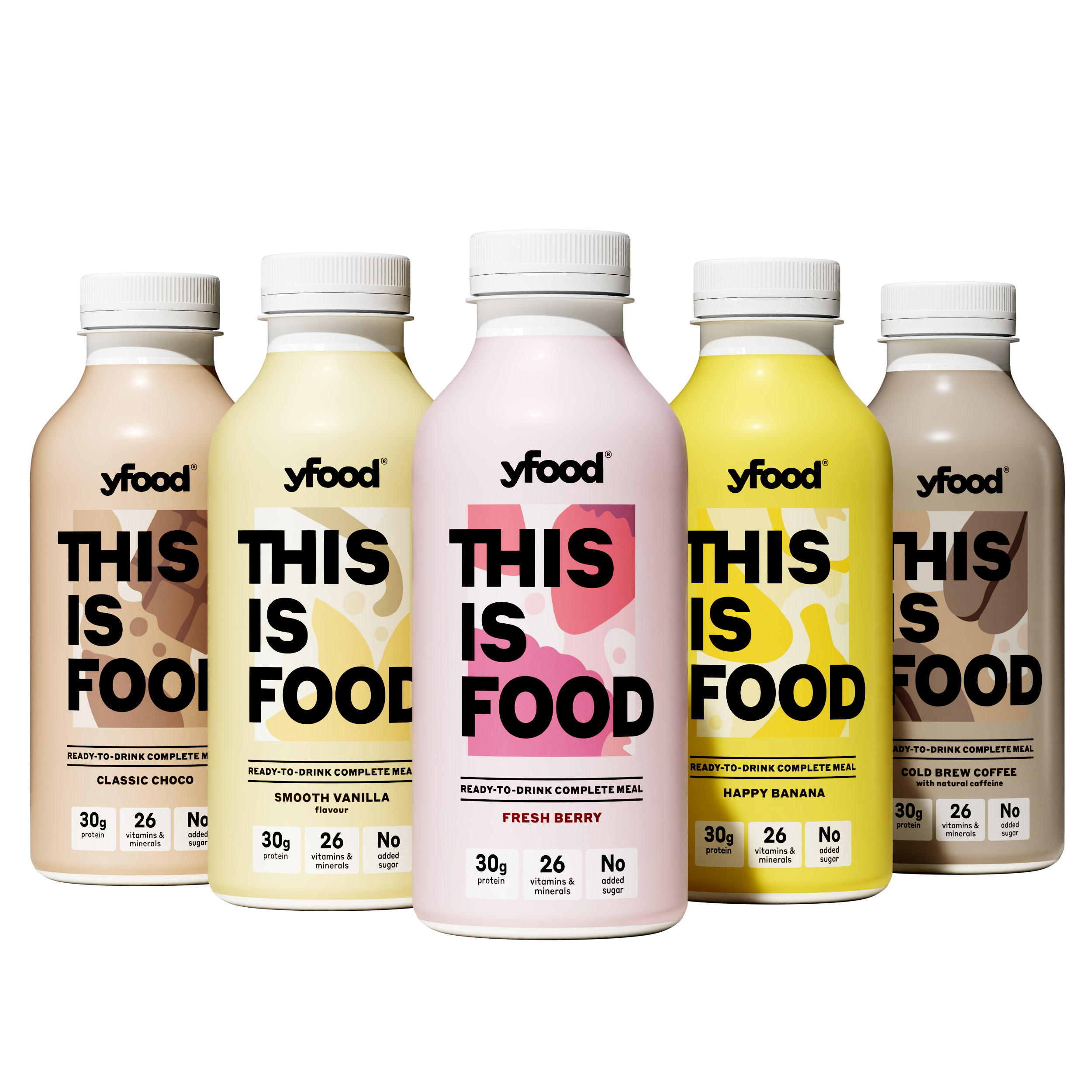Key takeaways
- Meal replacement drinks are shifting from weight-loss tools to lifestyle-focused nutrition solutions.
- GLP-1 drugs are disrupting the category by refocusing attention on rapid weight loss.
- Legacy diet brands are declining, while smart food brands are gaining traction with younger consumers.
- Yfood is leading a new wave of convenient, balanced products designed for real-life eating habits.
Meal replacement drinks seek to jam pack a beverage with all the components and nutrients of a healthy, balanced meal into a convenient beverage format, typically with fewer calories than a normal meal. But once considered the domain of weight loss programs, the category has evolved fast over the last decade — and its next evolution could be even faster as it keeps up with a changing world of GLP-1 drugs.
How consumer expectations around meal replacements are changing
The meal replacement category has seen two large trends emerge over the past 10 years, says Matthew Oster, head of health, beauty and hygiene insights at Euromonitor International, a data analytics company.
The first was a move away from the idea that meal replacement brands were purely for diets and people losing weight: instead, shifting its messaging to attract a larger receptive audience looking for nutritional and lifestyle solutions. But, conversely, the arrival of GLP-1 drugs has seen the focus shift back to weight loss.
“GLP-1s have complicated the narrative by putting weight loss back on the front pages,” says Oster. “From 2023 to now, weight loss as a trend has been predominant, with social media influencers taking advantage of the broader zeitgeist to promote brands and solutions to lose weight.”
Why GLP-1s are a challenge for the category
That puts the meal replacement category under pressure: how should they react to this new reality? And how big is the threat?
“At the moment, GLP-1s stand as a huge threat for the meal replacement category given that these prescription drugs produce quicker and deeper weight loss than meal replacements have traditionally promoted,” says Oster.
“However, given the relatively low penetration of GLP-1s (due largely to supply issues, high pricing, and some consumer reluctance to use the drugs), growth in meal replacement has been steady despite the risk of competing with GLP-1s.”
Which types of meal replacement brands are succeeding?
It means that legacy meal replacement brands (those focused on weight loss or diets, for example) have declined. But meanwhile, there’s a newer crop of meal replacement and meal-replacement-adjacent brands that are succeeding with a younger audience, both through nimble social media marketing and through formulations that meet consumers’ broader nutritive and lifestyle needs,” explains Oster.
Yfood and the rise of smart food
Munich-headquartered Yfood was founded in 2017 and is now available across 30 markets. In the UK, it’s now on shelves in more than 600 stores, from mainstream supermarkets such as Tesco and Sainsbury’s to specialist health food shops such as Holland & Barrett, with revenues up 115% year-on-year (2023 vs 2024).The brand’s narrative is not about weight loss; nor about replacing meals. Instead, it fits in a middle-ground which encompasses needs of consumers everywhere.
Why Yfood avoids the ‘diet’ label
“Yfood is not here to replace food culture, it’s here to support it,” explains Paul Sloane, Yfood’s UK & Ireland Country Manager. “We focus on convenience without compromise. For those moments when cooking isn’t an option, commuting, between meetings, after a workout, or during travel, Yfood delivers full nutritional value without sacrificing time or quality.
“We don’t position Yfood as a diet replacement or a permanent alternative to traditional food, but as a reliable companion that’s there when real life gets in the way.”

“Yfood is designed for everyone, not just for fitness enthusiasts or performance-driven consumers,” Sloane continues. “Our audience reflects a broad, modern demographic. They are conscious but pragmatic, looking for balance between health, convenience, and enjoyment. We are not just a sports nutrition or protein brand. We integrate into the everyday routines of busy people, from professionals with packed schedules to students and parents.
Essentially: “Yfood fits into real life, not an idealized version of it.”
Meeting consumers where they are
Yfood, sells across three key channels, each revealing a different element of its audience:
• Retail (including Tesco and Sainsburys): Strong performance here shows customers are planners: stocking up on products as a deliberate choice to simplify daily nutrition
• Convenience (including coop, petrol stations, WHSmiths at train stations and airports): Yfood also taps into the convenience occasion for unexpected occasions - missed meals by people on the go - when they still want quick, smart nutrition
• D2C (online shop): High loyalty: consumers often buy in bulk, showing they’ve integrated Yfood into their daily or weekly routine and trust the product to deliver.
What’s in a smart food drink?
So much so, that Yfood is leading a charge for the category away from the meal replacement label and towards the idea of ‘smart food’.
The drinks contain all 26 essential vitamins and minerals and up to 34g of protein, alongside fats, carbohydrates and dietary fibres. They are designed to keep you full for 3–5 hours (Yfood says research has shown the drinks to have superior satiety) and come in both dairy and vegan options.
Featuring a low glycaemic index, ensuring no rapid spike in blood sugar levels and a slower release of nutrients which also provides sustained energy, preventing post-meal sluggishness, Yfood’s meals feature no added sugar, and are lactose and gluten free.

“We see strong momentum in the smart food category,” says Sloane. “Consumers are moving beyond just protein, looking for complete, balanced, and health-conscious options they can trust. Yfood is at the forefront of this shift.”
What’s next for Yfood and the category?
Over the next five years, Sloane expects to see growth come from expanded formats: moving beyond drinks into bars, powders and other formats that support flexibility and different use cases. There’ll also be greater personalisation: with flavours and options for different preferences, tastes and dietary needs.
Find out more
Where once meal replacement shakes were the preserve of diet brands, meal replacement drinks and snacks are emerging as a robust category, for both GLP-1 patients and busy professionals. In a free-to-attend webinar, FoodNavigator explores how consumers are demanding full nutrition options, convenience and added functionality - and where this disruptive new sector is going next.

